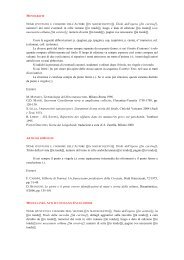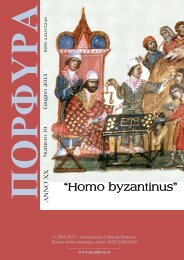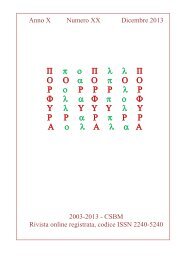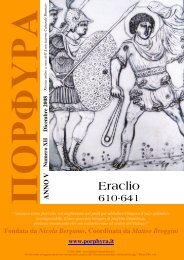ΠΟΡΦΥΡΑ - Porphyra
ΠΟΡΦΥΡΑ - Porphyra
ΠΟΡΦΥΡΑ - Porphyra
You also want an ePaper? Increase the reach of your titles
YUMPU automatically turns print PDFs into web optimized ePapers that Google loves.
A Prôtospatharios, Magistros, and Strategos Autokrator of 11 th cent.<br />
the equipment of Georgios Maniakes and his army according to the Skylitzes Matritensis miniatures<br />
and other artistic sources of the middle Byzantine period.<br />
from his linking to the blue faction, or to his Generalship, we<br />
should remember also that beside the red or red purple, the other<br />
favourite colour of the Emperor’s cloak in battle was normally<br />
blue purple. 133<br />
The chlamis was fastened on the right shoulder by a<br />
αγραφηs (fibula) 134 . The fastening fibula we have used in our<br />
reconstruction (Plate 1A) is copied by the cone-shaped fibula of<br />
Museum fur Kunst und Gewerbe of Hamburg, of 11 th cent. just<br />
coming from the Byzantine South Italy (fig. 7 n. 9), for its<br />
analogy with the φιβλιον shown in the folio 213v. 135<br />
In the same folio (fig 1) Maniakes wears two tunics: a<br />
light transparent undergarment, the so-called kamision, 136 in a<br />
vermillion dyed silk, and a superior cotton garment, called<br />
himation, i.e. the true military tunic 137 which reaches just below<br />
the waist but whose edge seems be covered, in this case, by the<br />
metallic belt of pteryges-kremasmata. The tunics represented in<br />
the miniature have no chevrons at the wrists, probably for<br />
military use: but the thin kamision is splendidly decorated with<br />
what seems be griffins, and pattern and colours resemble the<br />
authentic specimen of 9-10 th cent. preserved at Museum of Fine<br />
Arts of Boston 138 . The use of griffin images in the military<br />
context is a old East-Roman tradition, derived from Sassanid<br />
133 The most striking example is the miniature in Gr. 17 of Marciana representing Basil II in full armour, but see also<br />
the figures of Joshua and the Archangel Michael in the Menologion of Basil II, folio 3 : they are dressed as senior<br />
military commanders, Μιχαιλ as an Υπερστρατεγοs, Joshua as a Στρατεγοs. The first wears a purple gold<br />
embroidered διβιτισιον under a gold lamellar κλιβανιον, and a blue cloak on the shoulders. Joshua wears always a<br />
deep blue σαγιον, wrapped tranversally around his chest and tied up his mail λωρικιον. See Pio Franchi de Cavalieri,<br />
Il Menologio, p. 4 pl.3.<br />
134 To φιβλιον, η φιβλια ; see the history of S.Nilos from Rossano, where the monks are dressed like imperial<br />
dignitaries are known for their unusual way of fastening the cloak, Reiske, Commentarii, p. 65.; see De Cer. pp. 208-<br />
209 ; Kletorologion of Philotheos, in Oikonomidès, Les listes, pp. 166-167 and n. 144; and Ebersolt, Mèlanges, p. 55<br />
note 12.<br />
135 It is gold, with quartz of conical central emerald and pearl. Therefore seen in profile it is prominent in a conical<br />
shape. See Das Reich der Salier, 1024-1125, p. 161 n. 11.<br />
136 A short tunic like shirt, s. Du Cange, Glossarium, col. 563-564; Kletorologion of Philotheos, in Oikonomidès, Les<br />
listes, pp. 166-167 and n. 139 ; De Cer. 500-501, 574-577 ; Pio Franchi de Cavalieri, Come andavano armati, p. 217 on<br />
the found of a body of Roman Soldier of the 4 th century with a tunic worn over the inner Kamision; the body was intact,<br />
with pants (anaxyrides) of cloth with a flower pattern (ad modum oculorum caudae paonis) ; the very thin white<br />
interior tunic was underneath a red military tunic, whose colour, from the effects of damp, had discoloured the inner :<br />
“...subitus ad carnem...vestis serica albi maxime coloris sed tamen sub rubea...” in Inventio et Translatio Clarissimi<br />
Mart. Sancti Gereoni a Rudolpho Abb. S. Trudonis conscripta anno Domini 1121, apud Surium VI Coloniae<br />
Agrippinae 1579. p. 619 ; the Kamision as worn under a superior tunic is represented in a lot of different colour in the<br />
Menologion of Basil II, cfr. Pio Franchi de Cavalieri, Il Menologio, pls. 132, 153, 166.<br />
137 The use of the word himation for tunic in the Eastern Army is attested from at least the 6 th century onwards; see Peri<br />
Strategias, 54, 21; but especially the Strategikon of Maurikios, I, 2,46.; for the X-XI century s. Leo, Taktika, V,12; De<br />
Cer. 677-678 speaking of different kind of ιµατια used by the soldiers in the expedition against Crete in 949;<br />
Περι θαλασσοµαχιαs εκ του Τακτικον Νικηφορου Ουρανου, 119, 4 in Naumachica, 93.<br />
138 Muthesius A., Byzantine Silk Weaving, AD 400 to AD 1200, Wien 1997, pp. 44-57, 179 and pl. 75b ; the griffins are<br />
enclosed in medallions; every medaillon of the cloth is 20 cm. high. The medaillons are set in horizontal rows across<br />
the silk and linked by small roundels, up and down. Abstract, geometric ormanent fills the medaillon borders and the<br />
roundels, and the latter also have a ring of pearl shapes. Inside the medaillons, facing alternately to the left and to the<br />
right are winged griffins attacking quadrupeds (stags ?). The design is in natural fawn colour on purple ground.<br />
26

















